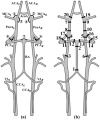Cerebral arterial architectonics and CFD simulation in mice with type 1 diabetes mellitus of different duration
- PMID: 33597584
- PMCID: PMC7889636
- DOI: 10.1038/s41598-021-83484-7
Cerebral arterial architectonics and CFD simulation in mice with type 1 diabetes mellitus of different duration
Abstract
Type 1 diabetes is a chronic autoimmune disease that affects tens of millions of people. Diabetes mellitus is one of the strongest factors in the development of cerebrovascular diseases. In this study we used NOD.CB17 Prkdcscid mice and the pharmacological model of type 1 diabetes mellitus of different duration to study changes in the cerebral vasculature. We used two combined approaches using magnetic resonance angiography both steady and transient CFD blood flow modeling. We identified the influence of type 1 diabetes on the architectonics and hemodynamics of the large blood vessels of the brain as the disease progresses. For the first time, we detected a statistically significant change in angioarchitectonics (the angles between the vessels of the circle of Willis, cross-sections areas of vessels) and hemodynamic (maximum blood flow rate, hydraulic resistance) in animals with diabetes duration of 2 months, that is manifested by the development of asymmetry of cerebral blood flow. The result shows the negative effect of diabetes on cerebral circulation as well as the practicability of CFD modeling. This may be of extensive interest, in pharmacological and preclinical studies.
Conflict of interest statement
The authors declare no competing interests.
Figures




Similar articles
-
Unilateral fetal-type circle of Willis anatomy causes right-left asymmetry in cerebral blood flow with pseudo-continuous arterial spin labeling: A limitation of arterial spin labeling-based cerebral blood flow measurements?J Cereb Blood Flow Metab. 2016 Sep;36(9):1570-8. doi: 10.1177/0271678X15626155. Epub 2016 Jan 11. J Cereb Blood Flow Metab. 2016. PMID: 26755444 Free PMC article.
-
Three-dimensional hemodynamics analysis of the circle of Willis in the patient-specific nonintegral arterial structures.Biomech Model Mechanobiol. 2016 Dec;15(6):1439-1456. doi: 10.1007/s10237-016-0773-6. Epub 2016 Mar 3. Biomech Model Mechanobiol. 2016. PMID: 26935302
-
Age-dependent cerebrovascular abnormalities and blood flow disturbances in APP23 mice modeling Alzheimer's disease.J Neurosci. 2003 Sep 17;23(24):8453-9. doi: 10.1523/JNEUROSCI.23-24-08453.2003. J Neurosci. 2003. PMID: 13679413 Free PMC article.
-
Anatomy of the cerebral vasculature.Neuroimaging Clin N Am. 1994 Nov;4(4):691-706. Neuroimaging Clin N Am. 1994. PMID: 7858916 Review.
-
Mixed perfusion: a combined blood supply to the brain tissue by multiple arteries.J Neuroradiol. 2010 Oct;37(4):201-10. doi: 10.1016/j.neurad.2010.01.035. Epub 2010 Apr 7. J Neuroradiol. 2010. PMID: 20378177 Review.
Cited by
-
Approaches to vascular network, blood flow, and metabolite distribution modeling in brain tissue.Biophys Rev. 2023 Aug 18;15(5):1335-1350. doi: 10.1007/s12551-023-01106-0. eCollection 2023 Oct. Biophys Rev. 2023. PMID: 37974995 Free PMC article. Review.
References
Publication types
MeSH terms
LinkOut - more resources
Full Text Sources
Other Literature Sources
Medical
Miscellaneous

